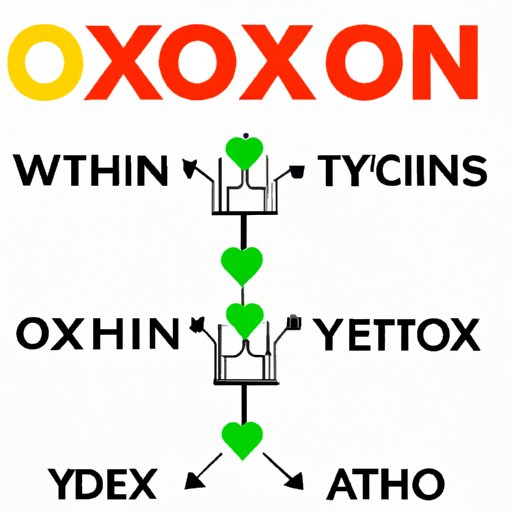Introduction
Oxytocin is a hormone produced in the body that is often referred to as the ‘love hormone’ due to its role in social bonding and emotional attachment. It is released during physical contact, such as hugging and cuddling, and has been linked to feelings of love, trust and connection.
In this article, we will explore how oxytocin makes us feel by looking at the neurochemistry of the hormone, examining its role in intimacy and attraction, exploring its impact on parent-child bonds, and investigating how it can affect our mental health and social interactions.

The Neurochemistry of Oxytocin: Exploring How the Hormone Makes Us Feel
Oxytocin is produced in the hypothalamus and stored in the pituitary gland. It is released into the bloodstream during moments of physical contact, such as hugging or cuddling, and can also be triggered by certain hormones, such as estrogen and testosterone. When oxytocin is released, it travels through the bloodstream and binds to receptors in the brain, where it impacts our emotions and behavior.
Studies have shown that oxytocin increases our sensitivity to social cues and can reduce stress levels. It has also been linked to increased generosity and trust, as well as reduced anxiety and fear. In addition, oxytocin has been found to play a role in the formation of memories, and has been associated with improved communication and understanding between people.
Love at First Sight: Examining the Role of Oxytocin in Intimacy and Attraction
Oxytocin plays an important role in romantic relationships, and is thought to be involved in feelings of attraction and desire. Studies have found that when oxytocin is released, people become more open and trusting, making them more likely to form strong emotional bonds with potential partners.
Research has also shown that oxytocin can influence the way we perceive potential partners. For example, studies have found that when oxytocin is released, people tend to find others more attractive and are more likely to focus on the positive aspects of a person. This suggests that oxytocin may be involved in the phenomenon of ‘love at first sight’.
Oxytocin and the Parent-Child Bond: Exploring the Science Behind the Emotional Connection
Oxytocin plays an important role in the formation of the parent-child bond. During childbirth, oxytocin is released in high levels, which helps to facilitate the process of labor. After birth, oxytocin continues to be released during physical contact, such as breastfeeding and cuddling, and has been linked to increased feelings of attachment and bonding between parent and child.
Research has also found that oxytocin can affect the development of attachment between parent and child. Studies have shown that children who receive more physical contact, such as hugs and kisses, are more likely to develop secure attachments than those who do not. This suggests that oxytocin may be involved in the formation of the parent-child bond.
Oxytocin and Mental Health: Exploring the Impact of the “Love Hormone” on Our Well-Being
Oxytocin has been linked to improved mental health and wellbeing. Studies have found that oxytocin can help to reduce stress and anxiety levels, and can also improve our moods and increase feelings of contentment. Furthermore, research has suggested that oxytocin may be involved in the treatment of depression, as it has been found to increase feelings of optimism and hope.
In addition, oxytocin has been linked to improved sleep quality, and has been found to help regulate appetite and maintain healthy weight. Overall, these findings suggest that oxytocin may play an important role in maintaining mental health and wellbeing.
Is Oxytocin Really Responsible for Trust and Cooperation? Examining the Evidence
Recent research has suggested that oxytocin may be involved in social interactions, such as trust and cooperation. Studies have found that when oxytocin is released, people tend to be more trusting and cooperative, suggesting that the hormone may be responsible for these behaviors.
However, it is important to note that the evidence is still inconclusive. While some studies have suggested that oxytocin may be responsible for trust and cooperation, other studies have failed to find a link. As such, further research is needed to fully understand the role of oxytocin in social interactions.

Oxytocin and Social Interactions: Investigating How the Hormone Influences Our Relationships
Oxytocin has been linked to improved communication and understanding between people. Studies have found that when oxytocin is released, people are more likely to listen to each other, show empathy and express their emotions more openly. Furthermore, research has suggested that oxytocin can help to strengthen existing relationships and can also facilitate the formation of new ones.
In addition, studies have found that oxytocin can have a positive effect on our relationships. Research has suggested that oxytocin can increase feelings of closeness and connection between people, and can also help to build trust and foster cooperation. These findings suggest that oxytocin may play an important role in our social interactions.
Conclusion
In conclusion, this article has explored how oxytocin makes us feel by looking at the neurochemistry of the hormone, examining its role in intimacy and attraction, exploring its impact on parent-child bonds, and investigating how it can affect our mental health and social interactions.
Overall, the evidence suggests that oxytocin plays an important role in our emotions and behavior, and can help to reduce stress levels, improve communication and understanding between people, and strengthen relationships. However, further research is needed to fully understand the role of oxytocin in social interactions.
If you would like to learn more about oxytocin, there are many resources available online. For further reading, please see the following links:
- The Role of Oxytocin in Social Bonding: A Review
- How Oxytocin Affects Mental Health
-
(Note: Is this article not meeting your expectations? Do you have knowledge or insights to share? Unlock new opportunities and expand your reach by joining our authors team. Click Registration to join us and share your expertise with our readers.)
